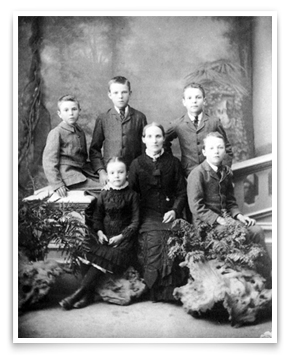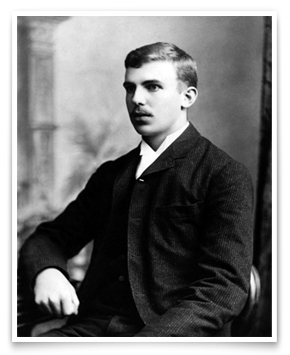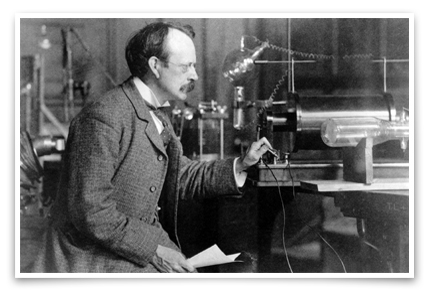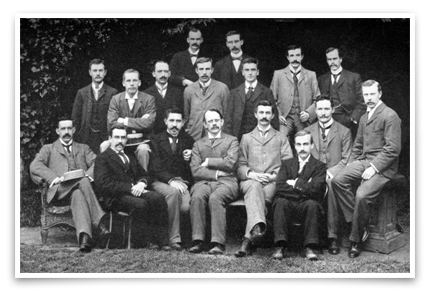Young Rutherford
From Colonial New Zealand to Cambridge, England, 1871–1898
 The house at Foxhill, where Ernest spent part of his childhood.
The house at Foxhill, where Ernest spent part of his childhood. The family of a later owner is in this photo. Credit: private collection.
How does a child from the edge of civilization end up being one of the most influential scientists of the 20th century? This is, in a sense, a practical question, since every age asks how it can produce better scientists. In the case of Ernest Rutherford, the answer is instructive. As a boy, he had every advantage that his modest circumstances provided. But his society provided no royal road to advancement, and he had no extraordinary advantages over others. He capitalized on the opportunities presented him. And his family and society accepted or at least tolerated his behavior until he succeeded.
Ernest Rutherford, whose father (aged 3) emigrated to New Zealand with his Scottish parents, was born in 1871. Ernest's mother, a school teacher, had also emigrated as a child from England with her widowed mother and grandparents. Three of Ernest's brothers and five sisters grew to adulthood; one brother died as an infant and two others died when Rutherford was 15. They drowned on an outing. Rutherford's mother entered a depression that she never overcame. His father, like his grandfather, was a wheelwright, a millwright, and a small farmer. The family was not wealthy, but neither was it poor. Young Rutherford worked in his father's sawmills and flaxmills.
 Martha Rutherford with Eva and (left to right) Charles, Ernest, Jim, and Herbert, 1885.
Martha Rutherford with Eva and (left to right) Charles, Ernest, Jim, and Herbert, 1885. Ernest was 14. Credit: Tyree, Rutherford family.
Rutherford thrived in this hardworking, country-town life, far from the perceived centers of colonial power. The town of Ernest's early teens was Havelock, on the northern coast of the South Island of New Zealand. Havelock had a pier for shipping, high forested hills, and equally elevated views across Kaikumera Bay. Beyond work and school, Ernest and his siblings and friends picked fruit in season, fished, and helped other local families when called upon. Subject to a larger economy, his family's fortunes fluctuated with the prices of flax and timber, but they got by.
The Rutherford children all learned reading and writing from their mother. They attended local schools through the primary and early teen years. The school in Havelock had only one teacher, two "pupil teachers," and about 100 students. Ernest was a quiet, 'unsporty' student through this period. At age 15 he considered entering the civil service and did well enough to be invited a year later to accept a position. One can see him, at this age, fretting over making a living, but other events intervened.
To move beyond a country town, a student needed to best other students on examinations. Rutherford failed to do this once, but the next year at 15 he succeeded. The runner-up succeeded in business later, and Rutherford chose further schooling over civil service or his father's business. Without the resulting scholarship (provided by public funds), Rutherford may have succeeded only in New Zealand. Instead, he played a crucial role in producing 20th-century physics. Note, however, that almost all the other boys and girls of his country town could go no further in school.
 Portrait of Rutherford in 1892, when he was a student at Canterbury College in Christchurch, New Zealand.
Portrait of Rutherford in 1892, when he was a student at Canterbury College in Christchurch, New Zealand.
Ernest went to Nelson College, 100 km away, run on the model of English public schools. He mastered every subject, earning prizes and scholarships in many subjects. He was best at mathematics. He was less accomplished in rugby, even though it was his best sport. He lived away from home for the first time and Nelson College re-oriented him toward a larger world.
 The Rutherford Den — Christchurch Arts Centre,
The Rutherford Den — Christchurch Arts Centre,New Zealand. An impression of the young Rutherford working at Canterbury College, Christchurch.
Credit: AIP Emilio Segrè Visual Archives.
In 1889, Rutherford was accepted to Canterbury College in Christchurch, but he fell short in the exams for a scholarship. With a year left of scholarship at Nelson College, he repeated a year. He qualified for a Junior Scholarship on the second attempt in 1890 and moved to Christchurch for a 3-year degree. He studied Latin, French, physics, and other courses. In year three, Rutherford conducted as many physics experiments as he could. On national exams, Rutherford achieved top marks and a Senior Scholarship (for the highest mathematics score) to return in 1893 for an "Honours" year. He concentrated on electricity and magnetism and worked mostly independently in the lab on high frequency magnetic induction and the magnetic viscosity of iron and steel.
 J.J. Thomson was Cavendish Professor and head of the Cavendish Laboratory from 1894 to 1919. J.J. is best known for his work on the electron.
J.J. Thomson was Cavendish Professor and head of the Cavendish Laboratory from 1894 to 1919. J.J. is best known for his work on the electron.Credit: Cambridge University, Cavendish Laboratory.
To go further in physics, Rutherford hoped to research at the Cavendish Laboratory in England. Fortunately for him, the first choice for the 1851 Exhibition Scholarship in 1895 withdrew and it went to Rutherford. Rutherford sailed for England, where he became the first “research student” at Cambridge University, i.e., the first non-graduate of Cambridge to enter directly into research. He quickly became part of J.J. Thomson's (1856–1940) family circle. J.J., as he was known, became Rutherford's most fervent promoter.
Rutherford soon made his mark at Cambridge. As Andrew Balfour then wrote: “We've got a rabbit here from the Antipodes and he's borrowing mighty deep.” (Eve, 1939, p. 14) Rutherford was ambitious and sought out physics problems that would make an impression. He latched first onto the transmission and detection of electromagnetic waves, i.e., radio. He extended transmission to about half a mile, but then he learned of Wilhelm Roentgen's mysterious X-rays. J.J. invited him to share his lab and work with him on the effect of X-rays on electrical conduction in gasses. He also placed Rutherford on the agenda for Royal Society and British Association meetings. Rutherford was on his way.
 J.J. Thomson, like many prominent physics professors in the late 19th century, gathered a group of bright young "research students" around him. Directly behind him is his protégé, Ernest Rutherford. Left of Rutherford is C.T.R. Wilson (known for his cloud chamber) and left of Thomson is Paul Langevin, who later worked with the Curies.
J.J. Thomson, like many prominent physics professors in the late 19th century, gathered a group of bright young "research students" around him. Directly behind him is his protégé, Ernest Rutherford. Left of Rutherford is C.T.R. Wilson (known for his cloud chamber) and left of Thomson is Paul Langevin, who later worked with the Curies.
On 30 October 1896, Rutherford wrote to Mary Newton, his sweetheart in New Zealand:
“I have some very big ideas which I hope to try and these, if successful, would be the making of me. Don't be surprised if you see a cable some morning that yours truly has discovered half-a-dozen new elements, for such is the direction my work is taking.”
(Eve, 1939, p. 39)
Following the discovery of radioactivity and new kinds of rays in 1896 in France by Pierre (1859–1906) and Marie Curie (1867–1934) and Henri Becquerel (1852–1908), Rutherford shifted from investigating ionization to studying the rays given off by radioactive materials. He discovered and named alpha (α) rays and beta (β) rays and started down a research path that did indeed make him famous.